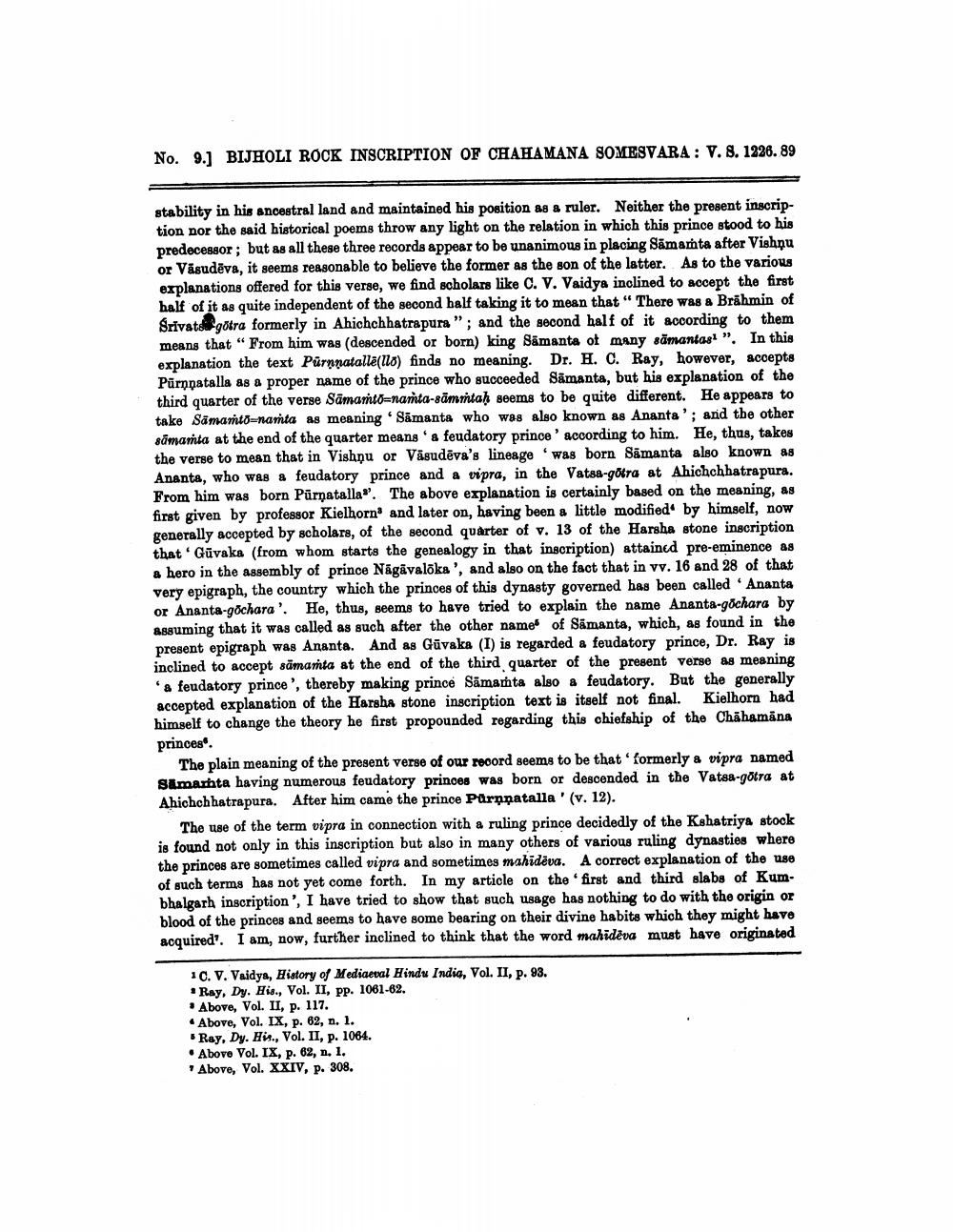________________
No. 9.] BIJHOLI ROCK INSCRIPTION OF CHAHAMANA SOMESVARA: V. 8. 1226. 89
stability in his ancestral land and maintained his position as a ruler. Neither the present inscription nor the said historical poems throw any light on the relation in which this prince stood to his predecessor; but as all these three records appear to be unanimous in placing Sāmamta after Vishnu or Väsudēva, it seems reasonable to believe the former as the son of the latter. As to the various explanations offered for this verse, we find scholars like C. V. Vaidya inclined to accept the first half of it as quite independent of the second half taking it to mean that “There was a Brāhmin of Srivate gotra formerly in Ahichchhatrapura"; and the second half of it according to them means that “From him was (descended or born) king Samanta of many sāmantası ". In this explanation the text Purnnatallē(llo) finds no meaning. Dr. H. C. Ray, however, accepts Pūrņpatalla as a proper name of the prince who succeeded Samanta, but his explanation of the third quarter of the verse Sämanto=nanta-sämmtah seems to be quite different. He appears to take Sämanto-narta as meaning Samanta who was also known as Ananta'; and the other sāmamta at the end of the quarter means a feudatory prince'acoording to him. He, thus, takes the verse to mean that in Vishnu or Väsudēva's lineage was born Sāmanta also known as Ananta, who was a feudatory prince and a vipra, in the Vatsa-gotra at Ahichchhatrapura. From him was born Purnatalla. The above explanation is certainly based on the meaning, as first given by professor Kielhorn' and later on, having been a little modified' by himself, now generally accepted by scholars, of the second quarter of v. 13 of the Harsha stone inscription that Güvaks (from whom starts the genealogy in that inscription) attained pre-eminence as a hero in the assembly of prince Nāgāvaloka', and also on the fact that in vv. 16 and 28 of that very epigraph, the country which the princes of this dynasty governed has been called 'Ananta or Ananta-gôchara'. He, thus, seems to have tried to explain the name Ananta-gôchara by 8.gguming that it was called as such after the other name of Samanta, which, as found in the present epigraph was Ananta. And as Gūvaka (I) is regarded a feudatory prince, Dr. Ray is inclined to accept sāmamta at the end of the third quarter of the present verse as meaning
a feudatory prince', thereby making prince Sāmamta also a feudatory. But the generally accepted explanation of the Harsha stone inscription text is itself not final. Kielhorn had himself to change the theory he first propounded regarding this chiefship of the Chāhamana princes.
The plain meaning of the present verse of our record seems to be that formerly a vipra named Samarhata having numerous feudatory princes was born or descended in the Vatsa-götra at Ahichchhatrapura. After him came the prince Parnnatalla' (v. 12).
The use of the term vipra in connection with a ruling prince decidedly of the Kshatriya stock is found not only in this inscription but also in many others of various ruling dynasties where the princes are sometimes called vipra and sometimes mahidēva. A correct explanation of the use of such terms has not yet come forth. In my article on the first and third slabs of Kumbhalgarh inscription', I have tried to show that such usage has nothing to do with the origin or blood of the princes and seems to have some bearing on their divine habits which they might have acquired. I am, now, further inclined to think that the word mahidēva must have originated
10. V. Vaidya, History of Mediaeval Hindu India, Vol. II, p. 93. * Ray, Dy. His., Vol. II, pp. 1061-62. * Above, Vol. II, p. 117.
Above, Vol. IX, p. 62, n. 1. *Ray, Dy. His., Vol. II, p. 1064. • Above Vol. IX, p. 62, n. 1. Above, Vol. XXIV, p. 308.




